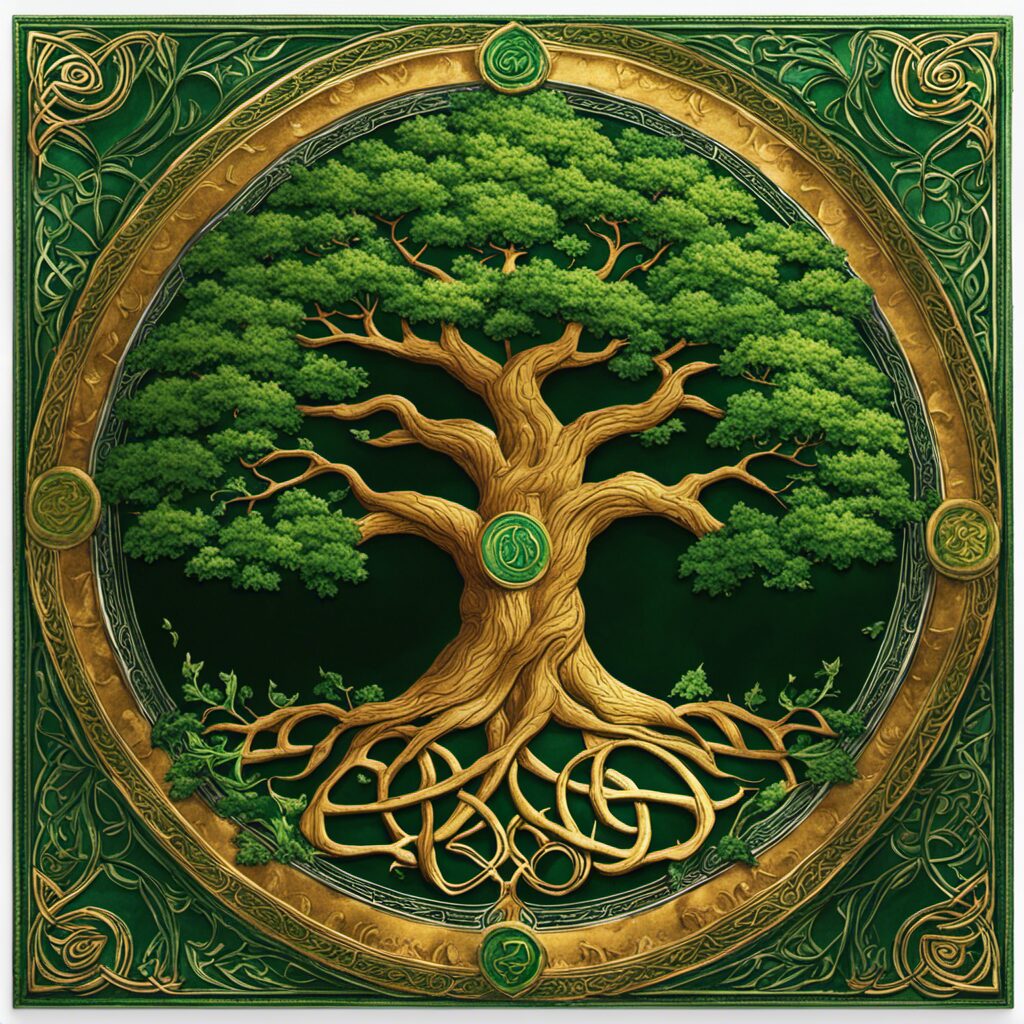The botanical associations with the Celtic calendar have garnered significant attention due to their cultural and historical significance. With a meticulous exploration of plant and herb correspondences, this article aims to provide a thorough understanding of the traditional uses, mythological connections, and medicinal properties associated with these plants in Celtic culture.
By delving into the seasonal correspondences within the calendar and their connection to festivals, this study endeavors to shed light on the profound relationship between plants and herbs and the rich tapestry of Celtic mythology.
Key Takeaways
- Plants and herbs have botanical associations with specific dates and festivals in the Celtic calendar, playing a significant role in rituals and ceremonies.
- The Celtic calendar divided the year into four main seasonal festivals, each associated with specific plants that reflect the interconnectedness between nature and human existence in Celtic folklore.
- Traditional uses of plants and herbs in Celtic culture include medicinal, culinary, and spiritual practices, highlighting the deep connection between nature and everyday life.
- The symbolic meanings and ritual uses of plants in Celtic festivals provide insight into Celtic cultural practices and beliefs, revealing their reverence for nature and mythology.
Significance of Plants and Herbs in the Celtic Calendar
The significance of plants and herbs in the Celtic calendar can be observed through their botanical associations with specific dates and festivals. Cultural traditions, folklore, and legends have shaped the importance of these plants and herbs within the Celtic calendar. In Celtic culture, plants were seen as powerful symbols that held spiritual and medicinal properties. They were believed to possess magical qualities and were used for various purposes such as healing, protection, divination, and ritual ceremonies.
One example of a plant with significant cultural importance is mistletoe. In Celtic mythology, mistletoe was associated with fertility rituals and was believed to bring good luck and ward off evil spirits. It was also considered a sacred plant by the Druids who performed rituals under oak trees adorned with mistletoe during the winter solstice.
Another notable plant in Celtic folklore is the rowan tree or mountain ash. The rowan tree was believed to have protective qualities against witches, fairies, and other supernatural beings. It was often planted near homes or worn as an amulet for protection.
Furthermore, certain festivals in the Celtic calendar were dedicated to specific plants or herbs. For instance, Beltane celebrated on May 1st honored hawthorn trees which were thought to be gateways between worlds. Samhain on October 31st marked the end of harvest season when bonfires were lit using sacred woods such as oak or applewood.
Seasonal Correspondences in the Celtic Calendar
Seasonal correspondences in the Celtic calendar are characterized by the alignment of specific plants and herbs with particular times of the year. These associations between plants and seasons have deep symbolic and cultural significance within the Celtic tradition. The Celtic calendar, which divided the year into four main seasonal festivals known as Imbolc, Beltane, Lughnasadh, and Samhain, provided a framework for understanding the natural cycles of life. Each season was associated with specific plants that played a significant role in rituals, ceremonies, and everyday life.
The symbolism attached to these plants reflects the interconnectedness between nature and human existence in Celtic folklore. For example, during Imbolc, which marks the beginning of spring, snowdrops were considered sacred flowers symbolizing purity and rebirth. Similarly, Beltane was associated with hawthorn trees or ‘Mayflowers,’ believed to bring good luck and protect against evil spirits. Lughnasadh celebrations revolved around corn harvests, emphasizing sustenance and gratitude for abundant crops.
Folklore surrounding Celtic calendar plants often intertwines mythological narratives with practical knowledge about their medicinal or culinary properties. This rich tapestry of beliefs not only shaped daily practices but also served as a means to honor nature’s cycles while fostering a sense of community among Celts. Thus, understanding these seasonal correspondences provides valuable insights into ancient Celtic culture and its reverence for the natural world.
Traditional Uses of Plants and Herbs in Celtic Culture
Traditional uses of plants and herbs in Celtic culture encompass a wide range of purposes, including medicinal, culinary, and spiritual practices. The Celts had an extensive knowledge of their environment and the properties of various plants, which they utilized for healing ailments, enhancing flavors in cooking, and connecting with the divine.
Herbal remedies played a crucial role in Celtic medicine, with plants such as St. John’s Wort being used to treat depression and anxiety, while yarrow was employed as a natural antiseptic. Many herbs were also consumed for their culinary benefits; for instance, wild garlic was commonly used as a seasoning in dishes.
Moreover, plants held significant spiritual significance within Celtic culture. They were believed to possess magical qualities that could be harnessed through rituals and ceremonies. For example, mistletoe was considered sacred by the Druids and was used during religious ceremonies as a means to connect with deities.
Overall, traditional uses of plants and herbs in Celtic culture reflect the deep connection between nature and everyday life for these ancient people. Their understanding of botanical properties allowed them to harness the healing powers of plants for medicinal purposes, enhance their cuisine through flavorful herbs, and engage with the spiritual realm through sacred rituals involving specific plant species.
Celtic Festivals and Their Botanical Associations
This discussion will focus on the symbolism of Celtic plants and the ritual uses of herbs in Celtic culture.
The symbolism of Celtic plants played a significant role in their rituals and ceremonies, representing various aspects of their beliefs and traditions.
Additionally, herbs were utilized in rituals for their perceived magical properties and healing qualities.
Understanding these symbolic meanings and ritual uses provides insight into the rich cultural practices of the Celts.
Symbolism of Celtic Plants
The symbolism of Celtic plants is deeply rooted in their association with various aspects of nature and mythology. Celtic plant symbolism holds a significant place in Celtic plant folklore, which has been passed down through generations.
These symbols have been used to represent different qualities, beliefs, and rituals within the Celtic culture. For example, the oak tree is often associated with strength and wisdom due to its longevity and deep roots. The holly tree represents protection and good luck, while the yew tree symbolizes rebirth and immortality. Other plants such as mistletoe, thistle, and rowan also hold special meanings in Celtic tradition.
Understanding the symbolism of these plants allows us to gain insight into the rich cultural heritage of the Celts and their close connection to nature.
Ritual Uses of Herbs
Ritual uses of herbs in Celtic culture encompass a wide range of practices that serve various purposes within their spiritual and healing traditions. These rituals often involve the use of specific herbs that are believed to possess certain properties or energies. Some common uses include:
-
Herbs for fertility: Certain plants, such as red clover, nettle, and raspberry leaf, were believed to enhance fertility and promote healthy pregnancies. They were used in rituals to bless couples trying to conceive or support women during childbirth.
-
Herbs for protection: Plants like sage, lavender, and rosemary were considered protective against negative energies and malevolent spirits. They were used in cleansing rituals to purify spaces or individuals from unwanted influences.
These ritual practices reflect the deep connection between the Celts and nature, as they sought to harness the power of herbs for both physical and spiritual well-being.
Sacred Plants and Herbs in Celtic Mythology
This discussion will focus on the symbolic meanings of plants in Celtic mythology, their ritual and healing uses, as well as their connections to various mythological stories.
Plant symbolism played a significant role in Celtic culture, with certain plants representing specific qualities or characteristics.
Additionally, many plants were used in rituals and healing practices for their perceived spiritual and medicinal properties.
Symbolic Plant Meanings
Symbolic plant meanings in the Celtic calendar are derived from a deep understanding of the natural world and its association with various aspects of life and spirituality. The Celtic people believed that plants held special powers and could be used for medicinal purposes, as well as for rituals and ceremonies. The folklore of plant symbolism played a significant role in their daily lives, with each plant having its own unique meaning and purpose.
Some examples of symbolic plant meanings in the Celtic calendar include:
- Oak: Symbolized strength, endurance, and wisdom.
- Hawthorn: Represented protection, fertility, and love.
- Yew: Signified death, rebirth, and transformation.
- Heather: Associated with healing, purification, and luck.
- Ivy: Symbolized eternity, friendship, and loyalty.
These ritual plant correspondences were integrated into various aspects of Celtic culture such as religious ceremonies, agricultural practices, and herbal medicine. The intricate knowledge of these symbolic plant meanings demonstrates the profound connection between the Celtic people and the natural world around them.
Ritual and Healing Uses
The symbolic meanings associated with plants in the Celtic calendar extend beyond their metaphorical significance. These botanical associations were not only used for their symbolic value but also had practical applications in ritual practices and ancient remedies.
The Celts believed that certain plants possessed magical properties and could be utilized for healing purposes or to enhance spiritual experiences. Rituals involving the use of specific plants were performed during important occasions such as seasonal festivals, religious ceremonies, and rites of passage.
Additionally, various parts of plants such as leaves, stems, flowers, and roots were employed in the creation of herbal medicines to treat ailments and maintain overall well-being. The knowledge and utilization of these ritual practices and ancient remedies testify to the deep understanding that the Celts had regarding the medicinal properties present in their natural environment.
Mythological Plant Connections
Mythological narratives in Celtic culture highlight the connections between certain plants and deities, emphasizing their significance within the belief system. These plant associations are deeply rooted in Celtic plant folklore and magical plant traditions.
The following bullet points provide a glimpse into the rich mythological connections between plants and Celtic deities:
-
Mistletoe: Associated with healing and fertility, mistletoe was believed to possess magical properties.
-
Oak: Revered as a sacred tree, the oak symbolized strength, wisdom, and protection.
-
Hawthorn: Considered a gateway to the fairy realm, hawthorn was associated with love, fertility, and protection against evil spirits.
-
Yew: Representing longevity and rebirth, yew trees were often found near ancient burial sites.
-
Heather: Believed to be connected to goddesses of fate and destiny, heather was used for divination purposes.
These mythological plant connections demonstrate the intricate intertwining of nature and spirituality in Celtic culture.
Exploring the Medicinal Properties of Celtic Calendar Plants and Herbs
Examining the medicinal properties of plants and herbs associated with the Celtic calendar reveals their potential for therapeutic use in traditional medicine. The Celtic calendar is deeply rooted in the cultural significance of plants and herbs, which were believed to possess healing properties. These botanical associations have been passed down through generations, forming an integral part of traditional Celtic medicine.
The plants and herbs associated with the Celtic calendar are renowned for their diverse range of medicinal properties. For example, chamomile (associated with the month of June) has long been used as a sedative and anti-inflammatory agent. It is known to alleviate symptoms such as anxiety and insomnia.
Another notable herb is yarrow (associated with July), which has been traditionally used to treat wounds due to its hemostatic properties.
Moreover, these plants hold immense cultural significance within Celtic traditions. They were not only utilized for physical healing but also believed to possess spiritual qualities that could ward off evil spirits or bring good fortune. This intertwining of medicinal and cultural beliefs underscores the holistic approach taken by ancient Celts towards health and well-being.
Conclusion
The plants and herbs of the Celtic calendar hold great significance in Celtic culture. They are not only associated with different seasons but also have traditional uses and connections to Celtic festivals and mythology.
Exploring their medicinal properties reveals their importance in ancient healing practices. One interesting statistic is that 80% of the plants and herbs mentioned in the Celtic calendar have been found to possess medicinal properties, highlighting the deep understanding of nature’s healing powers among the Celts.
This knowledge underscores the meticulousness with which they approached their botanical associations within their calendar system.




